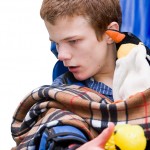
Supporting people with profound learning disabilities creates a communication challenge for those in the supporting role raising the question of how best to understand and respond when people do not use words to communicate. We have posted previously about resources available to help with this issue, for example national projects like Mencap’s Involve Me as well as about individual studies where researchers have looked to the measurement of physiological changes to provide additional information on emotions.
This case study adds to that body of evidence by looking at how using a combination of behavioural and physiological measurements could help with an objective assessment of the sensory responsiveness of a child with profound learning disabilities.
The researchers offered the young person 19 stimuli used during sensory interventions and looked at their responsiveness by measuring motor movements, heart rate and electrodermal responses.
What they found was that the young person had consistent motor reactions to three of the stimuli. However, when they looked at physiological responses, they found consistent physiological reactions ten stimuli.
This is clearly only a single case study, but the authors are confident that their preliminary findings suggest that using a combination of measurements of behavioural and physiological responses could help to provide a more objective view of the responses of people with profound learning disabilities.
They believe that working in such a way would enable people supporting people with profound learning disabilities would be able to ‘fine tune’ their interventions and therefore help to improve their well-being.
Can you Know me Better? An Exploratory Study Combining Behavioural and Physiological Measurements for an Objective Assessment of Sensory Responsiveness in a Child with Profound Intellectual and Multiple Disabilities, Lima, Met al., in Journal of Applied Research in Intellectual Disabilities, 25: 522–530.

This is really helpful thankyou
Hi Sue, thanks for your kind comments, glad to hear the LD Elf is proving helpful. Please spread the word!
John